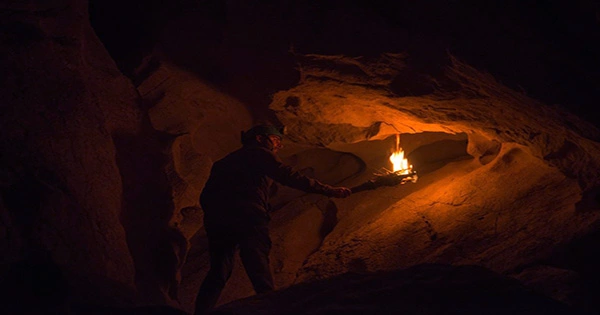Portable stone drawings and engravings, which date back to Paleolithic periods, may have been the first moving visuals. They were positioned around cave hearths, archaeologists believe, so that the people depicted would appear to come alive in the flickering light from the fires. Dr. Andy Needham of the University of York and co-authors write in PLOS ONE that “human brain is particularly responsive to interpreting altering light and shadow as movement.” In such circumstances, our pareidolia, or the ability to see faces in non-human forms, goes into overdrive.
While this phenomena is thought to have developed to protect our forefathers from night-hunting predators, some of our forefathers appear to have used the ability to make their art more powerful. After all, no one wanted the tribe’s youngest members to grow bored when the safest thing to do at night was to stay in the cave. The paleolithic equivalent of a Playstation or a movie may have been art that changed continually in the shifting firelight. The artwork Needham is referring to is not the magnificent cave drawings that we identify with Paleolithic art. Instead, they are plaquettes, which are tiny enough to be transported and flat enough to allow for visible engravings.
These plaquettes are most widespread from Portugal to Germany and neighboring islands, however they have been found all around Europe. Animals, people, and abstract symbols are shown, with occasional portrayals of what are assumed to be rivers in Magdalenian-style styles. Plaquettes were most likely employed in a variety of ways, including for their thermal qualities. Archaeologists, on the other hand, have frequently been unable to determine their purpose. Needham and co-authors studied 54 plaquettes composed largely of limestone that were obtained in the 19th century from the Montastruc rock shelter in Southern France.
The majority of the plaquettes include representations of bison, ibex, horses, and deer carved on them. Birds, parallel lines, and undefined things appear in a few. The lines are frequently altered to follow natural rock characteristics. The biggest have faces that are about the size of an A4 sheet of paper, but are 3 cm thick (1.2 inches). The majority of them are a fraction of that size. All of the limestones exhibit indications of heating after they were engraved, with cracking and thermal fractures apparent, as well as color changes particular to limestone heated to specified temperatures, which is critical for this research.
“These plaquettes would have been positioned near to heart structures at low light levels, presumably to emphasize the links between engraved shapes and natural elements in the rock,” the scientists write, “with the dynamic light thrown by the hearth bringing the portrayals to light.” That isn’t to say that their proximity to flames was only for this reason. Limestone might have also served a purpose by effectively distributing heat throughout the site and retaining it for after the fire was out, which the authors point out would have been critical during a period of extreme cold.
Cooking stones might have been made out of larger plaquettes. The engravings, on the other hand, would have been unneeded if they were their sole objectives. The researchers discovered that by placing imitation stones near open fires, the light increased the link between the natural form and the engravings, and the flowing flames made the carvings look dynamic. Some of the engravings, such as those depicting horse and ibex herds, appear to have been created expressly to achieve this effect.
We may have merely touched the surface of cave art’s creativity, especially in light of the emerging notion that certain cave paintings were positioned in regions where oxygen deprivation would cause hallucinations. Worked antlers discovered at Montastruc have been dated to roughly 14,000 years ago, near the end of the last Ice Age, but the plaquettes’ age is unknown.
















